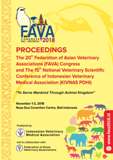AQ-9 Identification of Sumateran Wild Boar Meat (Sus scrofa vittatus) by Restriction Fragment Length Polymorphism (RFLP) Analysis of Cytochrome b Gene
Abstract
Sumateran wild boars have been super abundant in Sumateran forest. In Indonesia, this wildlife condition has led to the exploitation for commercial purpose. The high number of Sumateran wild boars population increases wild boar hunting resulting in an abundant availability of wild boar meat in the food market with extremely cheap price. The macroscopic similarity of wild boar meat and beef has prompted the local people to abuse this situation by selling wild boar meat in traditional market as beef. Based on annual record from Cilegon Class II Quarantine Office in 2014, there were nine smuggling cases or a total of 21.556 kg of wild boar meat smuggling effort that were prevented by Cilegon Quarantine officers. The number of food safety concerns related to smuggling of wild boar or counterfeiting beef with wild boar is a very detrimental condition for consumers, especially consumers in traditional markets.
The checking of genuineness or validity of food products is an important effort to protect people from consuming unhealthy food and to indicate whether the food is halal or not. Studies of meat detection should be continuously developed as an effort to protect consumers. Genetic method is the most specific and sensitive method to check food ingredients authenticity by detecting the presence of genetic material or deoxyribonucleic acid (DNA). It results from the specific character of the structure of DNA particles and the possibility of using the information included in them. The most frequent loci used for species identificationin phylogenetics and biodiversity studies are mitochondrial cytochrome b (cyt b).
Genetic method is the most specific and sensitive tool for analyzing the authenticity of food ingredients in a molecular level by means of detecting the presence of genetic material or deoxyribonucleic acid (DNA). One of the various methods could be used to detect genetic material is polymerase chain reaction (PCR). Specifically, one of such method frequently used in food industry to observe animal derived product fabrication is PCR restriction fragment length polymorphism (RFLP). PCR-RFLP is based on the comparison of the bands profile generated after certain enzymes digest the DNA target. PCR-RFLP is appropriate for meat testing due its ability in exploiting sequence variation in designated DNA region that allows species differentiation even from closely related species through DNA fragment restrictions selected by suitable restriction enzyme. PCR-RFLP is advantageous since it is simple, cheaper, and easier to be adjusted for routine big-scale studies such as surveillance program.

